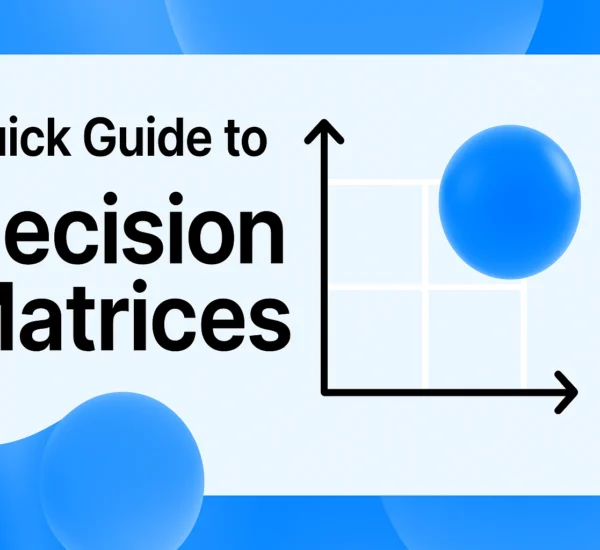Project management methodologies are structured frameworks guiding teams through project execution by offering systematic approaches tailored to different needs. Selecting the right methodology can improve project outcomes by aligning with specific requirements and goals.
- Introduction
- What is a project management methodology?
- Why are there so many different types of project management methodologies?
- The project management process: How to choose the right project management methodology
- 17 project management methodology examples and frameworks
- Choosing the right project management methodology
- FAQ
Introduction
Structured frameworks known as project management methodologies direct project managers and their teams through the complex task of executing a project. Aimed at today’s business professionals, these essential tools for project management help streamline processes and lead teams toward successful project completion. Moreover, these methodologies provide a way of thinking about and approaching the intricate organizational challenges that projects present.
Example
The Waterfall method is suitable for fixed requirement projects and has been effective in sectors like construction.
Project management methodologies hinge on flexibility and adaptability. They offer various structures—some more linear and some more adaptable—allowing the methodology to fit the project’s needs. The Waterfall method is perhaps the most recognized project management methodology. Use it when you have a project with fixed requirements and a plan that won’t change. Though it was developed for software engineering, it is suitable for projects in sectors like construction and manufacturing.
|
Methodology |
Best Suited For |
Key Characteristics |
|
Waterfall |
Fixed requirements |
Sequential, linear process |
|
Agile |
Evolving requirements |
Iterative, flexible approach |
|
Scrum |
Rapid build cycles |
Short sprints, regular feedback |
|
Kanban |
Visualizing work |
Continuous delivery, adaptability |
|
Lean |
Efficiency improvements |
Reducing waste, optimizing flow |
Understanding the rationale for using particular methodologies is vital. Methodologies do much more than provide directives; they create a common lexicon and understanding that enable teams to work together effectively.
Selecting methodologies that align with both the project and the team is crucial. When perfectly matched, project demands and team dynamics can lead to hybrid project management methods that are both flexible and well-structured.
Tip
Consider factors like budget, team composition, and stakeholder collaboration when selecting a methodology.
What is a project management methodology?
In productivity software, the first step to achieving effective project oversight is understanding what a project management methodology is. A project management methodology is a systematic way of combining principles, processes, and practices that project managers and their teams follow to achieve desired outcomes. When a group uses a methodology, it has a roadmap to follow, ensuring that all members know their roles and the sequence of tasks to perform. A shared methodology also provides a common vocabulary, so everyone understands terms like “deliverable” or “milestone.”
Fact
There is no single project management methodology that fits all types of projects; they each have benefits and uses.
The varied challenges in project management require the applied intelligence of project managers. Because projects have unique features and are often carried out in different environments, the development of project management has led to various methodologies suitable for different projects. A project’s success or failure is often directly correlated with the methodology used to manage it.
Consider:
- Waterfall Methodology: Ideal for projects with well-defined objectives, allowing for meticulous planning and clear expectations.
- Agile Methodology: Suited for projects requiring flexibility, enabling teams to adapt quickly to changing requirements and customer feedback.
- Scrum: A specific Agile approach that enhances team collaboration through iterative cycles.
- Kanban: Emphasizes visual workflow management, aiding teams in maintaining continuous delivery and addressing evolving requirements.
- Lean: Maximizes value by eliminating waste, suited for processes prioritizing efficiency.
The right methodology for a project greatly depends on factors such as complexity, duration, budget, and team composition. Aligning the methodology with the project’s objectives ensures that both are moving in the same direction, significantly increasing the likelihood of project success and offering a favorable return on investment.
Why are there so many different types of project management methodologies?
There are many different project management methods and frameworks. Why? Because projects and industries differ significantly. They operate under unique conditions and require specific approaches. When professionals choose a project framework, they often lean toward methodologies based on their previous experiences (good or bad), the types of frameworks they understand best, and the specific needs of the project, often leading to a hybridization of frameworks used.
Different approaches bring various benefits to fulfilling specific project demands. For example, the Waterfall method’s stepwise, linear nature is suitable for uncomplicated downstream tasks, often referred to as the “manufacturing” side of computing. Waterfall is best for well-defined projects where clear requirements are essential.
Tip
When selecting a methodology, consider the unique demands and conditions of your project and industry.
Conversely, Agile is favored in the rapidly changing software development sector due to its flexibility. Agile accommodates repeated course corrections when team members realize that an earlier decision was not optimal. It allows for steady, albeit sometimes uneven, progress, enabling team members to discover misalignments and make necessary adjustments.
For project leaders facing unpredictable demands, Kanban provides a clear framework for leading a team through project work. Its visual nature helps track progress and identify bottlenecks, ensuring steady delivery without overwhelming the team.
Simultaneously, the Lean methodology, rooted in manufacturing, focuses on maximizing value by minimizing waste. Lean is ideal for organizations prioritizing efficiency and streamlining processes. Similarly, Six Sigma aims for improvement rather than management, helping organizations achieve necessary precision in specific domains like healthcare and finance.
PRINCE2 applies to projects needing extensive documentation and controls, providing a structured approach that can fit almost any industry. Navigating project management can be complex; however, following PRINCE2 and utilizing other serious tools can lead to successful outcomes.
Fact
PRINCE2 can fit almost any industry, making it a widely applicable project management methodology.
Understanding these methodologies allows project managers to align projects with the most effective frameworks, thus improving efficiency. Each framework has its unique principles and tools, offering tailored solutions for specific project demands, including methodologies like Critical Path Method (CPM) and Extreme Programming, which address specific challenges in scheduling and software development, respectively.
The project management process: How to choose the right project management methodology
Selecting an appropriate project management methodology can significantly affect your projects’ outcomes. Your selection should be influenced by several factors, including the nature of the project, cost, team size, level of risk, required flexibility, and project timeline.
Start by assessing your project’s complexity. If it has fixed endpoints and minimal changes, the Waterfall method might be suitable. Following Waterfall is akin to navigating a well-known path where each step is clear and does not require alteration.
If your project has well-defined goals and a sequence of steps that must be followed, this could be a good method to employ.
Example
Agile is particularly effective in environments like software development, where quick responses to changes are necessary.
The Agile methodology is renowned for its adaptability, breaking work into small, manageable portions that allow teams to respond to ongoing feedback, ultimately satisfying project customers. However, Agile requires a solid structure to prevent losing track of the project’s progress.
The Adaptive methodology may be more suitable for projects in dynamic environments with constant shifts. This method promotes continuous learning and adjustment, making it ideal for projects with many unknowns, such as those involving new technologies. However, if your project has many stakeholders who are not aligned, this method could pose challenges.
Cost is another crucial factor. When resources are limited, and efficiency matters, Lean focuses on maximizing value while minimizing waste. Lean is not merely a set of rules but rather a collection of principles that can help streamline processes, especially when projects are time and budget-constrained.
Tip
Evaluate your project for risk and consider methodologies like Six Sigma for quality and precision.
Team size and skill level are also vital considerations. A smaller team may benefit from Scrum, which defines roles and iterations to enhance productivity. In contrast, Kanban can be utilized with teams of all sizes, emphasizing transparency and continuous improvement.
Evaluate your project for risk. For quality and precision, various flavors of Six Sigma are beneficial. These approaches aim to eliminate defects in processes and products, relying on data-driven decision-making methods. Six Sigma is particularly useful for projects that are defect-prone and require high quality.
Ultimately, choose what aligns best with the project’s current conditions and the organization’s long-term goals. Collaborate with your team to discuss their past experiences with various approaches; this will provide insight into what is most suitable for the project and the team.
17 project management methodology examples and frameworks
Project managers and team leaders must choose the best methodology to guide their work, given the wide array of methodologies available, each with its own set of promises and provisions.
Example
Agile is particularly beneficial for projects requiring fast adjustments and regular stakeholder interaction.
Here is an overview of 17 methodologies and frameworks to consider:
Agile emphasizes adaptability and collaboration, breaking projects into iterative cycles known as sprints. It’s particularly beneficial for projects requiring fast adjustments and regular stakeholder interaction. Within Agile, Scrum operates by dividing work into sprints and holding daily meetings to maintain team alignment, making it effective for continuous development projects.
Visual task management is the focus of Kanban. Using boards to manage tasks that require a specific workflow allows for tracking and fine-tuning of that workflow. It’s particularly useful for projects with expanding tasks, such as ongoing projects that may span several months.
The Lean methodology centers on efficiency, rooted in manufacturing and focused on eliminating waste while maximizing value. It is often used alongside quality improvement techniques, such as Six Sigma, which are also well-suited to the manufacturing context.
The Waterfall methodology offers a structured approach, progressing linearly through well-defined stages, making it suitable for projects with stable requirements and clear end goals. In contrast, Six Sigma utilizes data to understand problems better and find optimal solutions, often part of a Lean-Six Sigma toolkit that integrates various problem-solving methods.
Another well-established method is the Critical Path Method (CPM). This technique arranges vital tasks to create a project timeline. By identifying critical tasks, you can establish a comprehensive schedule. When managing more complex projects, you may need a more robust approach, which is where Critical Chain Project Management (CCPM) comes in.
Tip
Consider mixing methodologies like Agile and Waterfall for a tailored approach, often referred to as Hybrid.
The Hybrid method combines Agile’s adaptability with Waterfall’s organization, allowing teams to customize their approach to meet project demands effectively. For IT projects requiring a defined structure, PRINCE2 provides clear processes and roles for project teams.
Lean Six Sigma integrates Lean’s efficiency with the quality focus of Six Sigma to enhance processes while reducing waste. In fast-paced environments, Extreme Programming (XP) promotes rapid iteration to deliver quick results.
Other methodologies, such as Scrumban, exist between Scrum and Kanban, combining the agility of Scrum with Kanban’s visual task management approach for a balanced process.
The PMBOK® Guide is more of a collection of best practices than a strict methodology, providing a clear outline of necessary phases for structured execution while allowing project managers discretion within prescriptive steps.
Fact
Lean Startup, Design Thinking, and Lean UX focus on product development and innovation, serving the customer better.
Lastly, practices like Lean Startup, Design Thinking, and Lean UX innovate in product development and user experience, shifting focus from what a business can create to what it should create. They emphasize innovation that enables a business to serve its customers better while allowing for adaptability and new ideas.
When project managers understand these methodologies, they can select and customize an approach that aligns with the project’s demands, complexities, and objectives, ultimately leading to successful project outcomes.
Choosing the right project management methodology
Choosing the right project methodology can feel overwhelming, given the multitude of ways to complete a project.
Fact
This process is not about finding a single perfect, universal methodology, because none exists.
Instead, it involves understanding the strengths and weaknesses of various approaches to determine which is the best fit for your projects and team.
Each project has unique qualities and requires a careful evaluation to ascertain the most suitable methodology. This decision is not merely about following tradition or trends; it necessitates a strategic examination of your project’s specifics to achieve a successful outcome.
Factors to Consider
- Project Complexity: Assess how complex your project is. For example, methodologies like Scrum are beneficial for projects requiring rapid delivery and constant changes.
- Flexibility vs. Structure: Determine whether your project demands strict structure or flexible adaptation.
Example
Agile methodologies emphasize iterative progress and collaboration, perfect for projects needing ongoing adaptation.
- Team Dynamics: Consider your team’s strengths. Visual methods like Kanban support teams with continuous incoming tasks by visually managing workflow through boards.
- Resource Availability: Limited resources may necessitate a methodology focused on resource optimization.
- Collaboration Needs: If your project thrives on collaboration and frequent refinements, Agile frameworks like Scrum provide the necessary mechanism for regular, collaborative touchpoints that promote iterative growth.
Custom or Hybrid Approaches
Consider crafting a hybrid approach that borrows elements from multiple methodologies. This approach can combine the structured planning of PRINCE2 with the flexibility of Agile practices to tailor-fit your specific project requirements without sacrificing adaptability or organization.
Even after choosing a methodology, remain open to adjustments. Real-world application may reveal unforeseen challenges that necessitate changes. You might find that Lean principles work for you and your team, directing attention to maximizing value while minimizing waste and promoting efficient, high-quality outcomes.
Ultimately, the most suitable project management methodology for a particular team harmonizes the project’s goals with the team’s operating style. A methodology blends these aspects and remains adaptable and open to improvement, enabling project managers to guide their teams effectively and ensure better project delivery and enhanced team dynamics.
FAQ
The methodologies of project management frequently prompt inquiries from project managers and business professionals keen on refining their processes. Among the many questions asked, one of the most pertinent is the difference between Agile and Scrum. Both are vital to a comprehensive understanding of management strategies, yet each fulfills a distinct role in the broader context of project direction and completion.
Agile represents a philosophy that emphasizes adaptability, individual collaboration, and iterative progress. It respects the changing nature of software development, allowing for and even encouraging changes to project requirements as the work evolves. Scrum is an Agile framework structured to manage complex projects through short, focused work phases called sprints, which usually last one to four weeks.
Tip
If working in fast-paced or dynamic environments, Agile may suit better due to its adaptive nature.
Another often-asked question is why organizations might use these methodologies. The reasons are compelling. Agile allows for significant adaptability. Stakeholder feedback can be incorporated from all parts of the project and at any time, making it well-suited for dynamic environments where feedback is timely and relevant. Using Scrum allows project management to be broken down into manageable tasks, enhancing communication and ensuring regular adjustments.
Neither Agile nor Scrum is inherently better or worse; choosing between them is often a matter of team experience and project complexity. If you are working on a large project with changing goals or one that requires division into manageable chunks, Agile is preferable. Conversely, if your project has clear deadlines and sharply defined goals, Scrum is the better choice.
Project management tools can simplify these methodologies. Any.do, for instance, is a project management tool that goes beyond merely holding a list of tasks. It can help you create a task list and seamlessly integrate Agile and Scrum into your team’s workflow. Tools like Any.do’s project management capabilities facilitate the integration of Agile and Scrum practices. Additionally, it offers mobile apps for Android, iOS, and Windows, enabling you to use it anywhere.
Understanding these methodologies allows for better decision-making when challenges arise during a project. This preparation leads to better outcomes, as project managers and teams can adapt to various situations that may occur. A project that employs these principles has a higher chance of success and is more likely to be Agile in nature, even if the project manager does not explicitly claim to use Agile methods.


